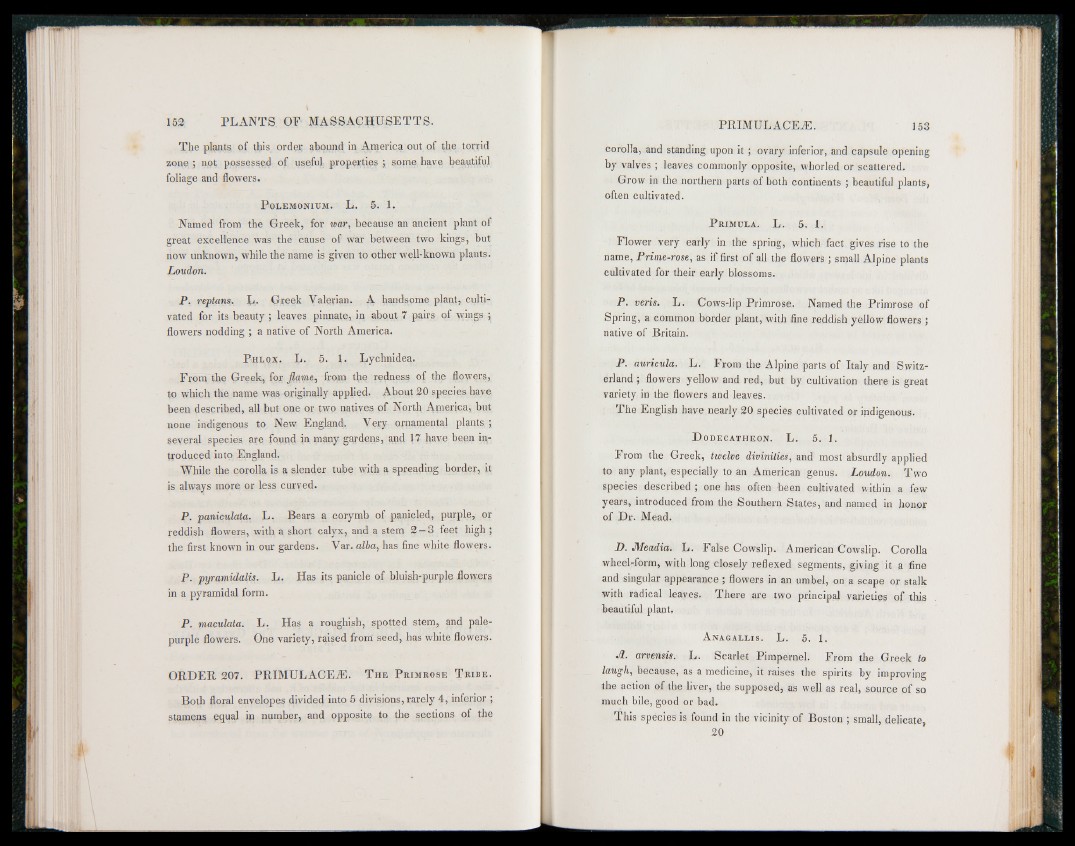
The plants of this order abound in America out of the torrid
zone ; not possessed of useful properties ; some have beautiful
foliage and flowers.
P&LEMQJtIUM. L. 5. 1.
Named from the Greek, for tear, because an ancient plant of
great excellence was the cause of war between two kings, but
now unknown, while the name is given to other well-known plants.
Loudon.
P. reptans. L. Greek Valerian. A handsome plant, cultivated
for its beauty ; leaves pinnate, in about 7 pairs of wings ;
flowers nodding ; a native of North America.
P hlox. L. 5. 1. Lychnidea.
From the Greek, for flame, from the redness of the flowers,
to which the name was originally applied. About 20 species have
been described, all but one or two natives of North America, but
none indigenous to New England. Very ornamental plants.;
several species are found in many gardens, and 17 have been introduced
into England.
While the corolla is a slender tube with a spreading border, it
is always more or less curved.
P. paniculata. L. Bears a corymb of panicled, purple, or
reddish flowers, with a short calyx, and a stem 2 - 3 feet high ;
the first known in our gardens. Var. alba, has fine white flowers.
P. pyramidalis. L. Has its panicle of bluish-purple flowers
in a pyramidal form.
P. maculata. L. Has a roughish, spotted stem, and pale-
purple flowers. One variety, raised from seed, has white flowers.
ORDER 207. PRIMULACEiE. T he P rimrose T r ib e .
Both floral envelopes divided into 5 divisions, rarely 4, inferior ;
stamens equal in number, and opposite to the sections of the
corolla, and standing upon it ; ovary inferior, and capsule opening
by valves ; leaves commonly opposite, whorled or scattered.
Grow in the northern parts of both continents ; beautiful plants,
often cultivated.
P rimula. L. 5. 1.
Flower very early in the spring, which fact gives rise to the
name, Prime-rose, as if first of all the flowers ; small Alpine plants
cultivated for their early blossoms.
P. veris. L. Cows-lip Primrose. Named the Primrose of
Spring, a common border plant, with fine reddish yellow flowers ;
native of Britain.
P. auricula. L. From the Alpine parts of Italy and Switzerland
; flowers yellow and red, but by cultivation there is great
variety in the flowers and leaves.
The English have nearly 20 species cultivated or indigenous,
D odecatheon. L. 5. 1.
From the Greek, twelve divinities, and most absurdly applied
to any plant, especially to an American genus. Loudon. Two
species described ; one has often been cultivated within a few
years, introduced from the Southern States, and named in honor
of Dr. Mead.
D. JWeadia. L. False Cowslip. American Cowslip. Corolla
wheel-form, with long closely reflexed segments, giving it a fine
and singular appearance ; flowers in an umbel, on a scape or stalk
with radical leaves, There are two principal varieties of this
beautiful plant,
A nagallis. L. 5. 1.
Jl. arvensis. L. Scarlet Pimpernel. From the Greek to
laugh, because, as a medicine, it raises the spirits by improving
the action of the liver, the supposed, as well as real, source of so
much bile, good or bad.
This species is found in the vicinity of Boston ; small, delicate,
20